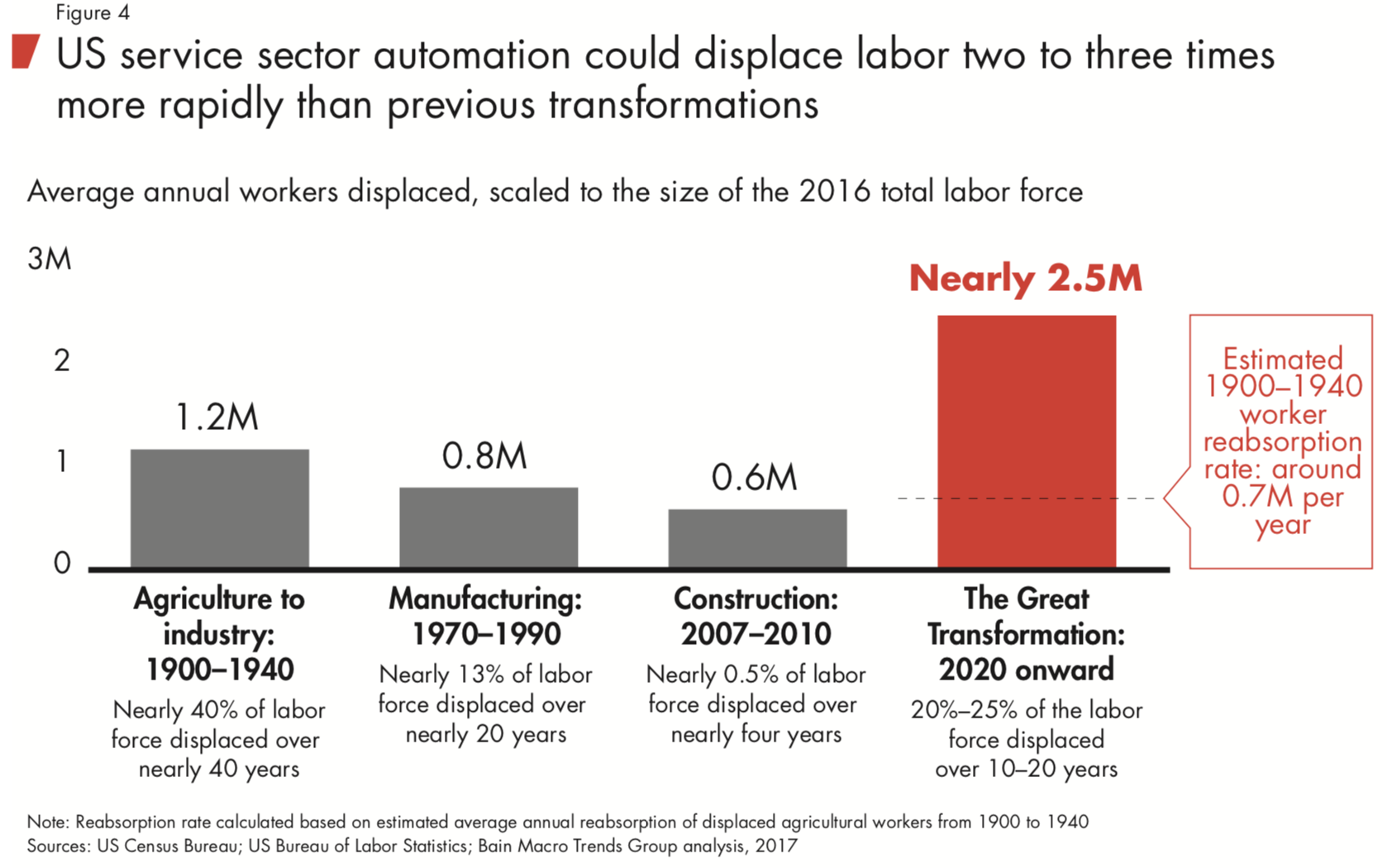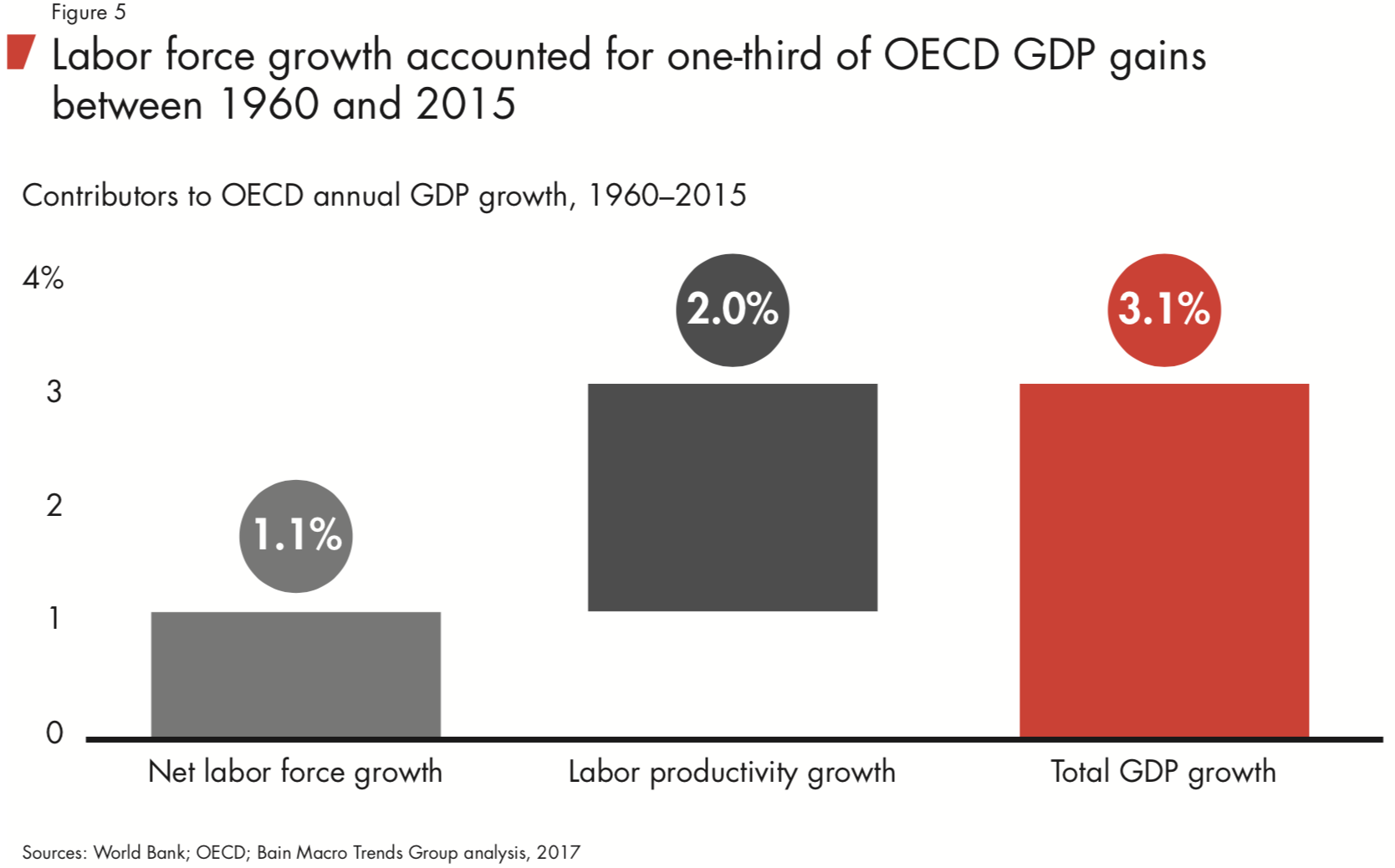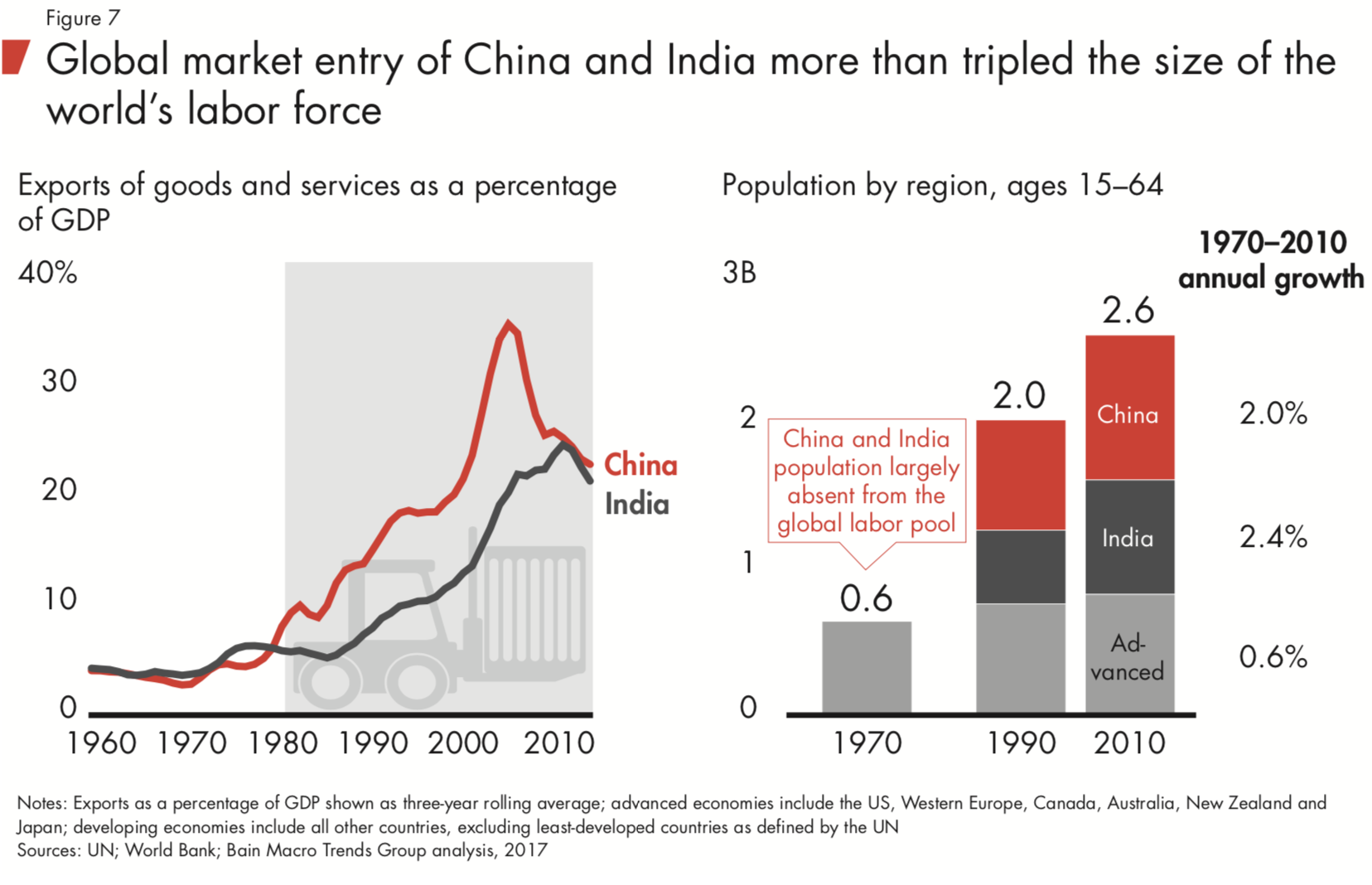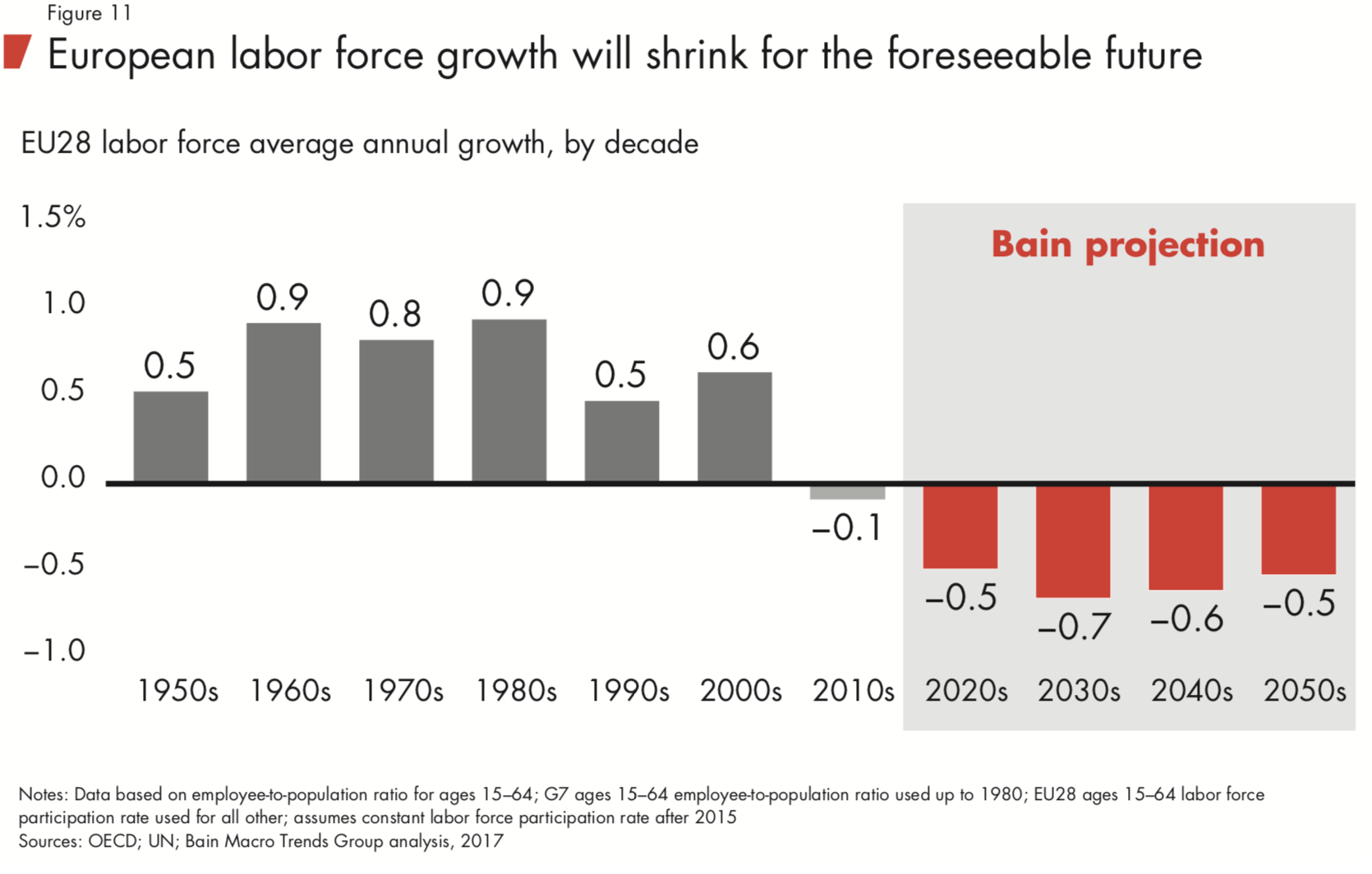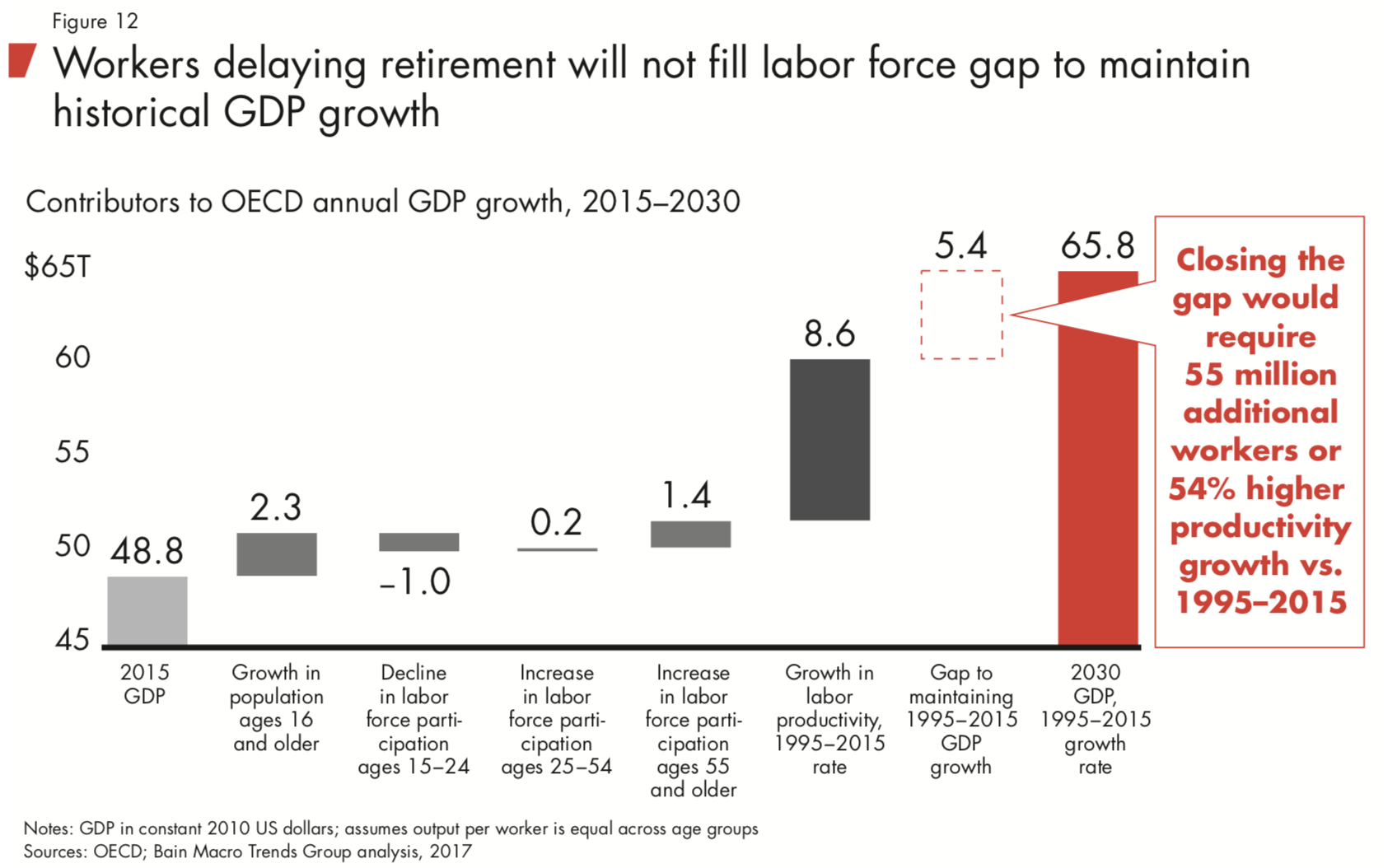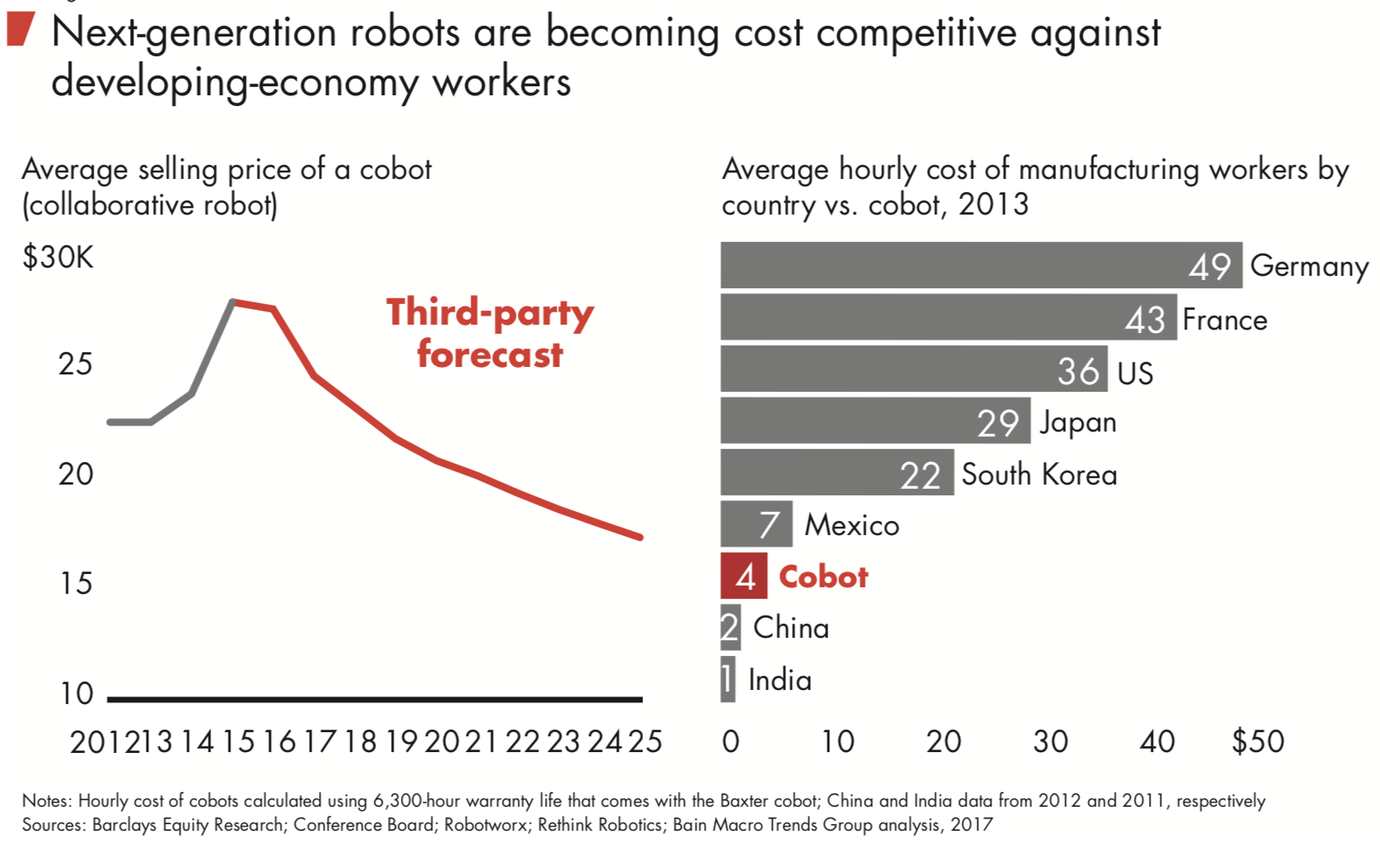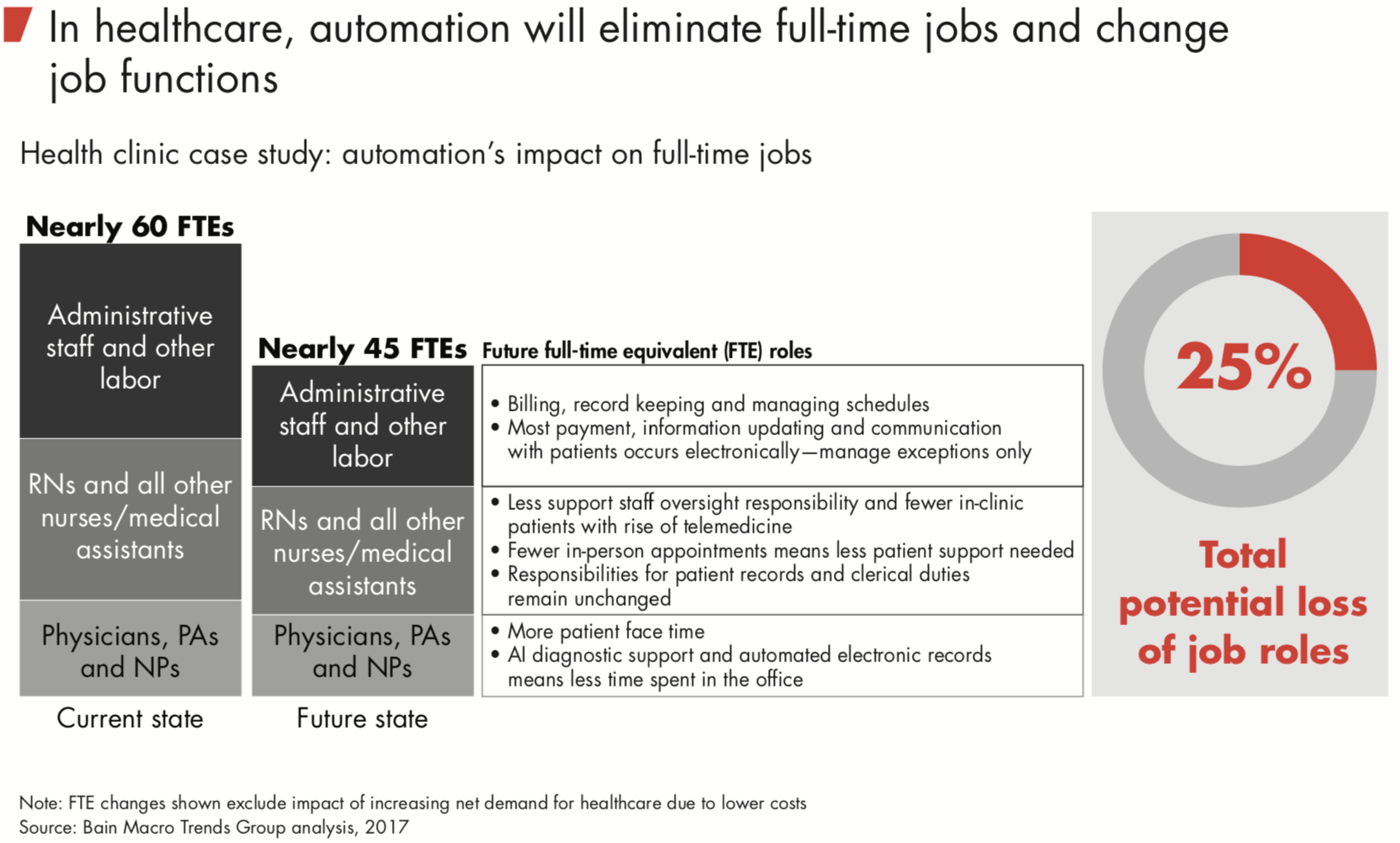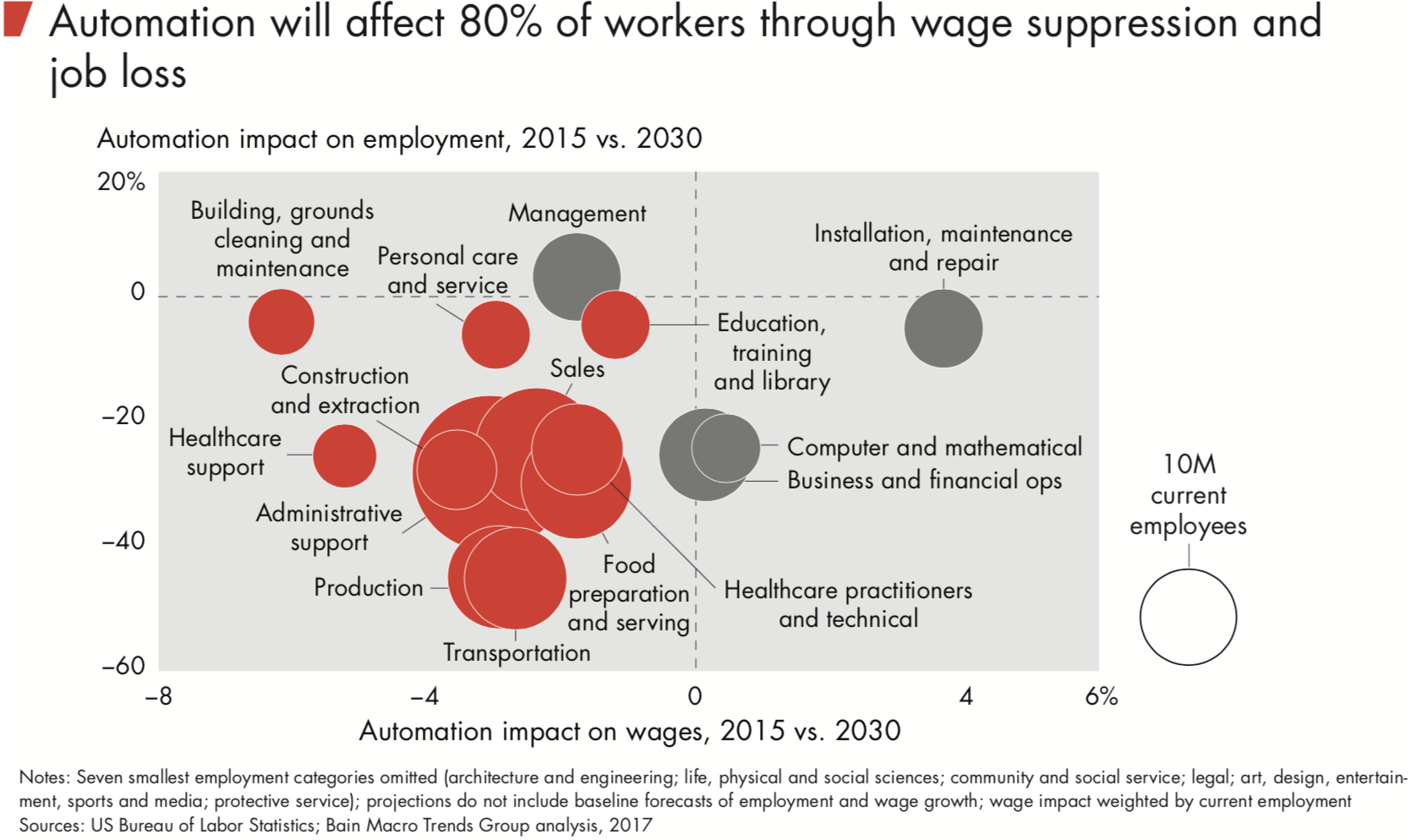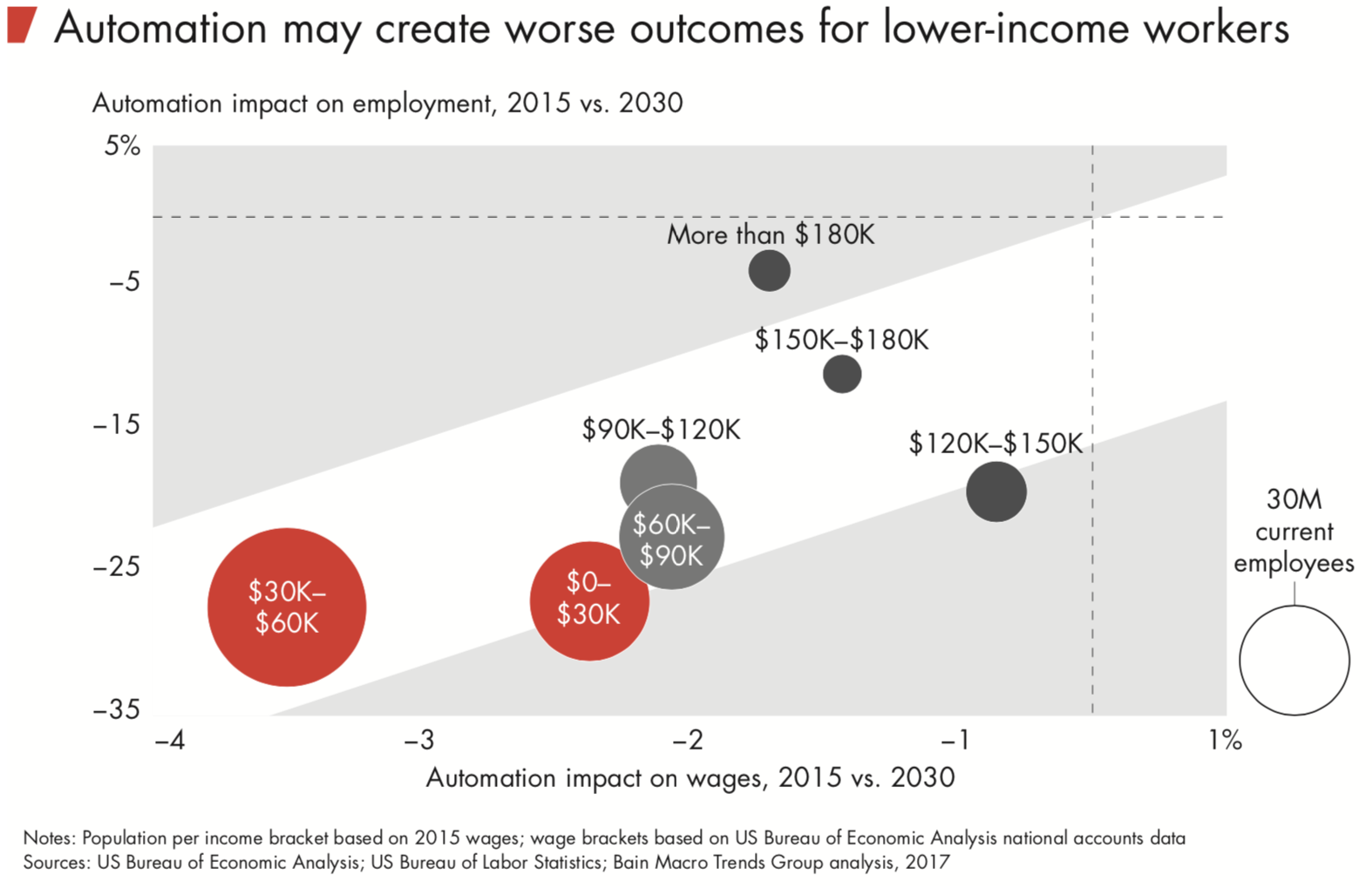BAIN: Fakten zu Folgen der Automatisierung
Automatisierung, Demografie und Ungleichheit sind bekanntlich Kernthemen von bto. Demografie und fehlende Produktivitätsfortschritte sind Kern der Eiszeit-These, verbunden mit der Überschuldung. Automatisierung kann eine Chance sein, die Eiszeit zu überwinden und ist für mich in der Tat gerade für Gesellschaften wie unsere mehr Chance als Risiko. Ich weiß aber, dass dies gerne auch anders gesehen wird.
Grund genug, eine Studie der Unternehmensberatung BAIN hier zu diskutieren. BAIN & COMPANY gehört zu den Top 3 weltweit und ist gerade in jüngster Zeit auch in Deutschland sehr erfolgreich.
Doch nun zur Studie:
- “Demographics, automation and inequality have the potential to dramatically reshape our world in the 2020s and beyond. Our analysis shows that the collision of these forces could trigger economic disruption far greater than we have experienced over the past 60 years.” – bto: Verbinden wir das noch mit der Schuldenkrise, wird es lustig.
- “The majority of the world’s workforce is aging rapidly. We forecast US labor force growth, for instance, will slow to 0.4 % per year in the 2020s. That major demographic shift is bringing an end to the abundance of labor that has fueled economic growth since the 1970s. (…) As the total size of the labor force stagnates or declines in many markets, the momentum for economic growth should slow.” – bto: Das ist inzwischen allgemein bekannt.
- “(…) governments will face major challenges, including surging healthcare costs, old-age pensions and high debt levels. On the plus side, the lagging wages of mid- to lower-skilled workers in advanced economies should benefit from the simple economics of greater demand and lesser supply.” – bto: Hätte ich auch gedacht. Bisher tritt der Effekt aber nicht ein, auch in Japan nicht. Ich denke, dies hat mit dem weltweit weiter steigenden Arbeitskräfteangebot zu tun.
- Sodann zeigen sich die Berater als Optimisten, was die Produktivitätsfortschritte betrifft:
“Faced with a rising scarcity of labor, companies and investors are likely to draw increasingly on automation technologies (…) Our analysis shows automation is likely to push output potential far ahead of demand potential. The rapid spread of automation may eliminate as many as 20% to 25% of current jobs — equivalent to 40 million displaced workers — and depress wage growth for many more workers.” – bto: Die Zahlen beziehen sich auf die USA. Sie sagen also, das Angebot wächst viel stärker als die Nachfrage. Das bedeutet Deflation, was die Schulden endgültig untragbar macht – und wir bekommen ein neues Prekariat. - “The benefits of automation will likely flow to about 20 % of workers — primarily highly compensated, highly skilled workers — as well as to the owners of capital. The growing scarcity of highly skilled workers may push their incomes even higher relative to lesser-skilled workers. As a result, automation has the potential to significantly increase income inequality and, by extension, wealth inequality.” – bto: Das kann so sein. Man könnte auch sagen, dass es zu mehr Regulierung und Besteuerung kommt.
- “(…) a (…) rapid rollout over 10 to 20 years would trigger a massive investment surge, up to an incremental $8 trillion in the US alone, based on our estimates. Much of the added output potential would be directed back toward meeting investment demand, pushing overall growth rates back up to levels seen in the 1980s and 1990s.” – bto: Da hätte ich gerne gesehen, wie sie das berechnet haben.
- “(…) rapid automation of the US service sector, for example, could eliminate jobs two to three times more rapidly than in previous transformations (see Figure 4). As the investment wave recedes, it may leave in its wake deeply unbalanced economies in which income is concentrated among those most likely to save and invest, not consume. Growth at that point would become deeply demand constrained, exposing the full magnitude of labor market disruption temporarily hidden from view by the investment boom.
In der Tat würde es eine enorme Verwerfung für die Gesellschaft mit sich bringen:
Quelle: BAIN
- “Optimists argue that the clear pattern of history is that creating more value with fewer resources has led to rising material wealth and prosperity for centuries. We see no reason to believe that this time will be different — eventually. But the time horizon for our analysis stretches only into the early 2030s, about 15 to 20 years from now. Relieving the imbalances causing the stagnation in that time period means changing the pattern of income distribution somehow, shifting income toward those inclined to spend rather than save. (…) historically, governments confronted with serious economic imbalances often have opted for a more active role in reshaping market-based outcomes.” – bto: Das haben wir ja schon: Mietpreisbremse, Rekordabgaben …
Soweit die Einführung. Danach geht es mit mehr Details um die OECD-Staaten:
-
“Labor force growth and labor productivity growth form the two halves of the equation that determine overall economic output growth. Labor productivity growth without the kicker from labor force growth can create an overall macroeconomic climate of stagnation — Japan’s lost decades are a good example of this phenomenon. Between 1960 and 2015, one-third of total output growth among OECD member nations was due to labor force growth.” – bto: weshalb es so wichtig ist, gegenzusteuern, wenn wir der Eiszeit entkommen wollen:
Quelle: BAIN
Als dann das Wachstum im Westen nachließ – der Rückgang des Bevölkerungswachstums – und die Baby-Boomer sich der Rente näherten, kam es bekanntlich zum Angebotsschock im weltweiten Arbeitsmarkt:
Quelle: BAIN
Besonders ausgeprägt ist der Rückgang der Erwerbsbevölkerung in Europa:
Quelle: BAIN
Danach berechnen die Berater den Verlust an BIP gegenüber einer Trendfortschreibung der letzten 20 Jahre (die bereits die Finanzkrise und die Folgen beinhalten, also unter dem Vorkrisentrend liegen):
Quelle: BAIN
Hier kommt nun die Produktivität ins Spiel. Zunächst zeigt BAIN, was wir wissen. Nämlich, dass die Produktivitätszuwächse seit Jahren rückläufig sind, was auch damit zu tun hat, dass weniger investiert wird.
Dies soll sich durch die bevorstehende Automatisierungswelle ändern: “We estimate that by 2030 these technologies could increase labor productivity by an average of 30% compared with 2015, with rising impact over time. This step-change improvement varies considerably by industry and ranges from relatively modest levels in healthcare and educational services to substantial impact in industries such as food service, retail, transportation and warehousing.” – bto: Das ist einleuchtend und deckt sich mit den Vermutungen anderer Beobachter.
Quelle: BAIN
- “Cobots, which sit alongside humans to enhance labor productivity in manufacturing, are an example of how companies are closing the cost gap. These helper robots cost less than one-quarter the price of traditional robots, and by 2013, they were already cheaper than human workers in every advanced economy and most developing economies. By enhancing the productivity of their human counterparts, automation will likely make manufacturing costs attractive closer to home shores.” – bto: Das kann man unter Umweltgesichtspunkten begrüßen, reduziert es doch den Transport um die Welt. Wenn man sich das Chart ansieht, erkennt man, vor welchem gewaltigen Druck gerade auch Deutschland steht – ein Albtraumszenario angesichts der Bildung der Zuwanderung.
Quelle: BAIN
- “Our analysis concludes that the coming phase of automation could eventually eliminate up to 50 % of all current jobs. The job activity analysis only suggests the potential of technology to replace humans with hardware and software.” – bto: wohl dem Land, das den Rückgang der Bevölkerung akzeptiert und nicht auf Migration setzt!
- “The full impact of automation likely won’t play out until after 2030 because cheap labor will continue to be available in some sectors and some businesses will be slower to adopt automation. However, in some sectors, automation may put downward pressure on wages long before workers are displaced. For example, the introduction of self-service kiosks and smartphone-based ordering technology in quick-service restaurants is likely to place a ceiling on order-taking wages at the point which it becomes cheaper to automate than employ a human order taker.” – bto: Es geht frontal gegen jene Jobs, die die Zuwanderer ausüben könnten.
Und für jene, die meinen, in Krankenhäusern und in der Pflege wäre kein Wandel zu erwarten, dem sei diese Beispielrechnung eine Warnung.
Quelle: BAIN
Was dann zum Blick auf alle Branchen führt: weniger Arbeitsplätze und geringere Löhne, wohin man blickt.
Quelle: BAIN
Ich halte es für plausibel. Denn im Unterschied zu den früheren Revolutionen geht es diesmal vor allem um Bildung. Deshalb ist es ein so großes Problem, dass wir weltweit ein Bevölkerungswachstum haben, das nicht mit der Bildung einhergeht. Siehe PISA-Ergebnisse in Afrika und dem Nahen Osten. Damit produzieren wir Arbeitslose ohne Perspektive.
Danach beschäftigt sich BAIN ausführlich mit der Ungleichheit und der vermuteten Einkommensentwicklung der einzelnen Alterskohorten, um dann zur entscheidenden, ebenfalls nicht überraschenden Erkenntnis zu kommen: Es trifft die Armen.
Quelle: BAIN
Das wiederum würde ich als zusätzlich problematisch ansehen, weil wir es schon heute mit einem hohen Anteil an Migranten bei den Armen zu tun haben. Unsere kräftige Zuwanderung von niedrig Qualifizierten schafft uns in Kombination mit dem massiven technologischen Wandel ein erhebliches soziales und wirtschaftliches Problem.
Auch Thomas Piketty dürfte seine wahre Freude an der Prognose von BAIN haben, dass aufgrund dieser Entwicklung der Anteil der Lohneinkommen am BIP weiter schrumpft. Eigentlich würde man ja nach Jahren des Rückgangs eine Zunahme der Lohnquote erwarten. Doch danach sieht es für die Analysten von BAIN nicht aus:
Was dann zum kombinierten Ausblick führt:
- “Over the past four decades, economies around the world have increasingly struggled with weak demand growth. An economy firing on all cylinders should grow faster, but a persistent lack of demand growth has restrained overall growth. Intermittent bouts of debt-fueled investment and consumption have temporarily boosted demand only to be followed by a crash and a time of readjustment. The best example of this was the global financial crisis and the Great Recession, the impacts of which are only now subsiding in many countries.” – bto: So ist es. Wir haben mit Schulden die Illusion von Wohlstand geweckt.
- “Societal aging is bringing an end to plentiful labor growth, but older populations will continue to fuel steady demand. In isolation, this trend should create the potential for relatively balanced demand growth vs. supply growth and a generally more sustainable, if lackluster, economy. However, the rapid spread of automation and worsening income inequality push in the opposite direction. Automation, in particular, has the potential to significantly increase supply growth, but the job losses and wage pressures it triggers should act to restrain demand growth likely from the middle of the 2020s on.” – bto: also ein massiv deflationäres Szenario, das alle Schulden untragbar macht.
- “The magnitude of automation we anticipate would require a significant surge of capital investment, (…) comparison might be to (…) the Roaring Twenties when robust investment in the automotive, radio and petrochemicals industries, along with associated infrastructure spending on roads, electrical grids, telephone lines and the consequent urbanization, created a period of increased labor productivity and increased economic growth. In this type of investment boom, supply growth creates the demand for more supply — a virtuous cycle of growth. However, as investment saturation sets in, financial capital ebbs, and new machinery and equipment is left with-out sufficient demand.” – bto: Das ist sicherlich eine sehr interessante Überlegung.
Bain kommt damit zu einem gemischten Ergebnis: Viele Industrien werden revolutioniert, das Produktivitätswachstum nimmt deutlich zu, aber die Nachfrage wird fehlen, weil ein großer Teil der Bevölkerung Arbeit verliert und die alternde Gesellschaft ohnehin weniger konsumiert. Die Ungleichheit wird steigen und damit der Druck auf Regierungen, mehr umzuverteilen und mehr zu regulieren.
Ich würde ergänzen:
- Die Studie unterstreicht die fatale Logik einer Zuwanderung von gering qualifizierten Menschen, da diese dauerhaft von Transfers leben werden.
- Es wird deutlich, dass es besser ist, voll auf den Trend der Automatisierung zu setzen, weil er ohnehin kommt. Also Roboter statt Zuwanderer.
- Es wird zu einem deflationären Schock in der Welt führen und ist damit nicht die Lösung für die Schuldenprobleme der Welt, sondern ein weiteres Problem.
- BAIN geht von steigenden Zinsen wegen des gestiegenen Kapitalbedarfs für die Investitionen aus. Das kann sein. Es kann aber auch sein, dass die Notenbanken die Zinsen tief halten, weil sie denken, sie könnten die Anpassung so erleichtern.
Auf jeden Fall erhöht es die Turbulenzen in der Weltwirtschaft und es ist durchaus realistisch, wenn BAIN “Jahrzehnte der Disruption erwartet“.
→ bain.de: “LABOR 2030: THE COLLISION OF DEMOGRAPHICS, AUTOMATION AND INEQUALITY





